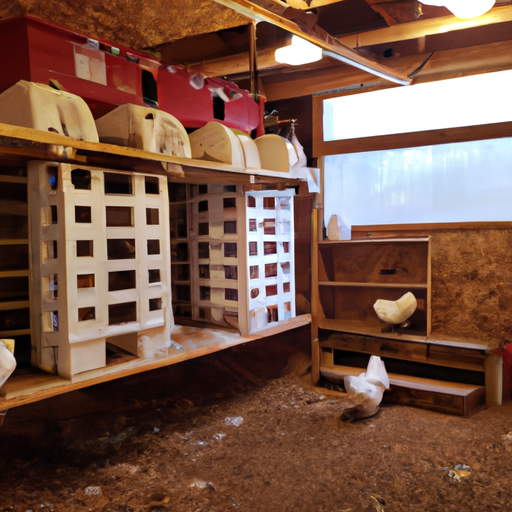Have you ever wondered how the size of a flock can impact the space and housing needs of its members? In this article, we will explore the correlation between flock size and the requirements for adequate space and housing. Whether you’re a farmer looking to optimize your poultry management practices or someone interested in learning more about the welfare and well-being of our feathered friends, read on to discover the fascinating relationship between flock size and their living environment.
Factors to Consider
When it comes to providing the best living environment for your feathered friends, there are several factors to consider. The species of birds, their age, and their activity level all play a significant role in determining the space and housing requirements. By understanding the unique characteristics of each factor, you can create a comfortable and suitable habitat for your flock.
Species of Birds
Different bird species have distinct behavior patterns and varying social hierarchies. It’s essential to consider these factors when planning their living space. For example, chickens are known for their pecking order and need adequate space to establish their hierarchy peacefully. Ducks, on the other hand, require plenty of water, so a habitat with a pond or pool would be beneficial. Turkeys, known for their large size, need sufficient space to roam and spread their wings.
Age of Birds
The age of your birds also affects their space and housing requirements. Young chicks, regardless of species, have different needs compared to adult birds. They require a secure and warm shelter, such as a brooder, to protect them from predators and extreme temperatures. As they grow, their need for space increases. It’s important to provide enough room for their growth and development.
Activity Level
Birds have varying levels of activity. Some breeds are naturally more active, while others prefer a more laid-back lifestyle. Active breeds, such as the Leghorn chicken or the Muscovy duck, benefit from having ample space to roam and engage in their natural behaviors. Less active breeds, like the Silkie chicken or the Pekin duck, may still need sufficient room to move around comfortably, but they may not require as much space for exercise.
Space Requirements
Proper space allocation is crucial for the well-being of your flock. Ensuring that each bird has enough room helps prevent overcrowding and reduces stress and territorial disputes. Here are some key aspects to consider when determining the space requirements for your birds:
Minimum Space per Bird
As a general guideline, chickens require a minimum of 4 square feet per bird in the coop and at least 10 square feet in the outdoor run or forage area. Ducks need a bit more space and should have around 6-8 square feet in the coop and 20 square feet in the run. Turkeys, due to their larger size, need even more space, with approximately 8-10 square feet in the coop and 50 square feet in the run.
Roosting and Sleeping Areas
Birds need a designated area to rest and sleep comfortably. Provide enough perch space for each bird to roost comfortably at night. The perches should be at least 8-12 inches long and positioned 2-3 feet above the ground.
Nesting Boxes
If you plan on raising hens for egg production, providing nesting boxes is essential. Each nesting box should be approximately 12×12 inches and placed at a suitable height off the ground, making it easy for the hens to access and lay their eggs.
Feeding and Drinking Areas
Birds require access to fresh food and water at all times. Provide enough feeding and drinking areas to prevent competition and ensure all birds have equal access. Depending on the size of your flock, multiple feeding stations and waterers may be necessary.
Run and Forage Space
Allowing your birds to have access to a designated outdoor run or forage area enables them to engage in natural behaviors like pecking and scratching. The size of the run should be large enough to accommodate the flock’s activity level, with ample space for exercise and foraging.
Housing Requirements
Apart from space considerations, the housing itself plays a crucial role in providing a safe and comfortable environment for your birds. Here are some key housing requirements to keep in mind:
Coop Size
The coop should be spacious enough to comfortably accommodate the flock, allowing for movement and nesting areas. As a general rule, aim for at least 4 square feet of coop space per chicken and 10 square feet for ducks. Turkeys will require a larger coop due to their size, with approximately 8-10 square feet per bird.
Ventilation
Good ventilation is essential to maintain a healthy and odor-free environment inside the coop. Proper air circulation helps reduce the buildup of ammonia and prevents respiratory issues in your birds. Ensure there are enough windows or vents to allow fresh air to flow through.
Insulation
Insulating the coop helps regulate temperatures, keeping your birds comfortable in both hot and cold weather. Consider using materials like straw, hay, or insulation boards to provide adequate insulation.
Lighting
Proper lighting is crucial for your flock’s health and productivity. Birds, like humans, require a balance of light and darkness. Ensure there is enough natural or artificial light in the coop, mimicking the natural day-night cycle.
Protection from Predators
One of the primary functions of housing is to protect your birds from predators. Ensure that the coop is secure, with sturdy walls, predator-proof fencing, and a lockable door. Consider installing wire mesh hardware cloth to prevent entry from smaller predators like raccoons or weasels.
Flock Sizes and Space Requirements
The number of birds in your flock determines the space they need. Whether you have a small, medium, or large flock, it’s essential to consider their space requirements carefully.
Small Flock Size
A small flock typically consists of 2-5 birds. For such a small group, a smaller coop and run area may suffice. Aim for the minimum space requirements mentioned earlier, ensuring that each bird has enough space to thrive.
Medium Flock Size
A medium-sized flock usually ranges from 6-15 birds. With a larger number of birds, you’ll need to increase the coop and run size accordingly. Providing extra perches, nesting boxes, and feeding areas becomes even more important.
Large Flock Size
A large flock can consist of 16 or more birds. For such a significant number, you’ll need a substantial coop and a spacious outdoor run or foraging area. Dividing the coop into separate pens or sections can help manage large flocks more efficiently.
Considerations for Overcrowding
It’s crucial to avoid overcrowding your flock, regardless of its size. Overcrowding can lead to increased stress, aggressive behavior, and poor health. It’s better to have a smaller, well-managed flock than to overcrowd and risk the overall well-being of your birds.
Flock Sizes and Housing Requirements
When considering flock size and housing requirements, there are a few key aspects to keep in mind:
Coop Size
As mentioned earlier, the coop should be appropriately sized to accommodate the number of birds in your flock comfortably. A larger flock will require a more spacious coop to prevent overcrowding and ensure adequate roosting and nesting areas.
Number of Nesting Boxes
The number of nesting boxes should be proportional to the flock size. Aim for one nesting box per 3-4 hens to prevent competition and ensure that all birds have access to a comfortable and private space to lay their eggs.
Watering and Feeding Equipment
With a larger flock, multiple waterers and feeding stations may be required to prevent overcrowding and ensure equal access to food and water.
Ease of Movement and Social Interactions
Providing enough space for your flock to move around freely and interact socially is important for their well-being. A crowded coop can lead to increased stress and aggressive behavior. Adequate space ensures that birds can move comfortably and establish their hierarchy without constant conflict.
Effects of Insufficient Space and Housing
Insufficient space and housing can have various negative effects on your flock’s health and overall well-being. It’s important to avoid these consequences by providing adequate space and suitable housing for your birds:
Stress and Aggression
Overcrowding can lead to increased stress levels and territorial disputes among birds. Lack of space can make it challenging for them to establish a natural hierarchy, resulting in heightened aggression and harm.
Poor Health and Hygiene
Insufficient space and poor ventilation can lead to inadequate air circulation and stagnant air, increasing the risk of respiratory issues. Overcrowded living conditions also make it difficult to maintain proper hygiene, leading to the accumulation of waste and the spread of diseases.
Reduced Egg Production and Hatchability
Hens in overcrowded or stressful environments may experience a decline in egg production and fertility. The stress and lack of space can negatively impact their reproductive capabilities, leading to reduced egg production and hatchability rates.
Increased Risk of Disease Transmission
Overcrowding and poor sanitation make it easier for diseases to spread within the flock. Close proximity and limited space create an ideal environment for disease transmission, jeopardizing the health of your birds.
Conclusion
The importance of appropriate space and housing cannot be overstated when it comes to raising a healthy and thriving flock. Considering the species, age, and activity level of your birds will help you tailor their living environment to their specific needs. By providing sufficient space, proper housing, and suitable amenities, you can create a comfortable and safe habitat that promotes their well-being. Remember, a well-cared-for flock will reward you with healthier birds, higher egg production, and a more enjoyable experience overall.




